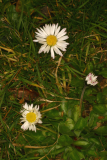Additional notes (click to expand)
Medicinal
Pains of the joints and gout, as an ointment mixed with mallows. As an enema for fevers and intestinal colic. Juice of the leves and roots sniffed up the nose for migraine. Crushed leaves as a poultice for bruises (Old name was bruisewort). Juice clears the eyes ands tops them watering. Field daisies as a tea, good against fevers, inflammation of the liver and intestines.
Gerard, J. (1975). The Herbal or General History of Plants. New York: Fascimile Dover Publications Inc . p.637
In homeopathy to treat sprains, bruises, boils and eczema.
Podlech, D. (1996). Herbs & Healing Plants of Britain & Europe, Collins p.186
Nomenclature
'Daizies' are in Culpeper as synonymous with Consolida minima - which appears in the Pharmacopoeia Londinensis (1650).
Culpeper, Nicholas. (1650). A Physical Directory . London, Peter Cole. page 25
Other use
Young leaves and petals are added to salads.
Podlech, D. (1996). Herbs & Healing Plants of Britain & Europe, Collins p.186
Geographical distribution
- Africa, Northern Africa, Morocco
- Asia-Temperate, Caucasus, Transcaucasus
- Asia-Temperate, Western Asia, Afghanistan
- Asia-Temperate, Western Asia, Cyprus
- Asia-Temperate, Western Asia, Iran
- Asia-Temperate, Western Asia, Iraq
- Asia-Temperate, Western Asia, Israel
- Asia-Temperate, Western Asia, Jordan
- Asia-Temperate, Western Asia, Lebanon-Syria
- Asia-Temperate, Western Asia, Turkey
- Europe, Eastern Europe
- Europe, Middle Europe
- Europe, Northern Europe
- Europe, Northern Europe, Great Britain
- Europe, Southeastern Europe
- Europe, Southwestern Europe
Bellis perennis L.
Family: ASTERACEAEGenus: Bellis
Species: perennis L.
Common names: Daisy
Distribution summary: N.Africa, W.Asia, Europe
Habit: Perennial
Hardiness: H5 - Hardy; cold winter
Habitat: Short grassland
Garden status: Not currently grown
Flowering months: March, April, May, June, July, August, September, October
Reason for growing: Medicinal



.JPG)